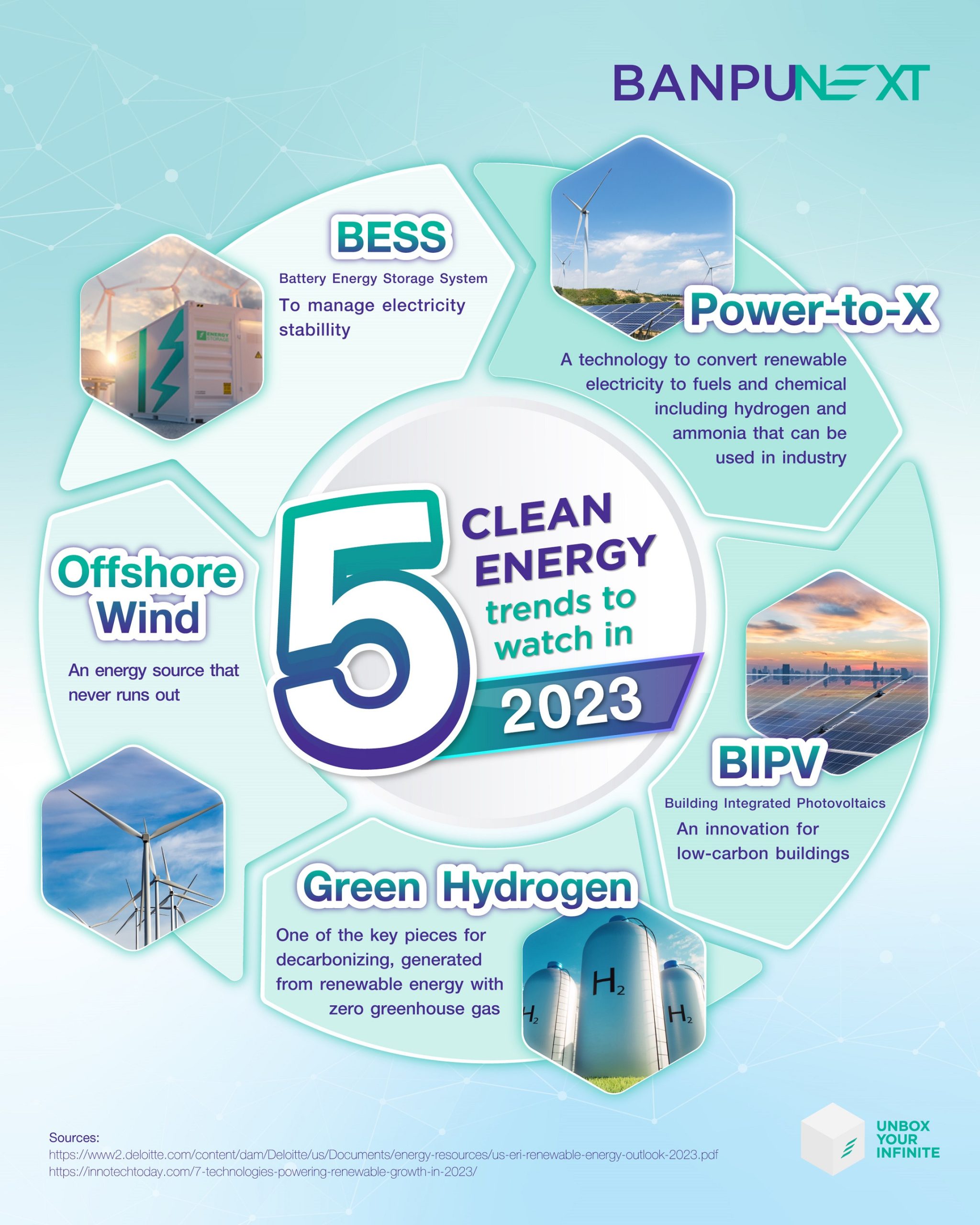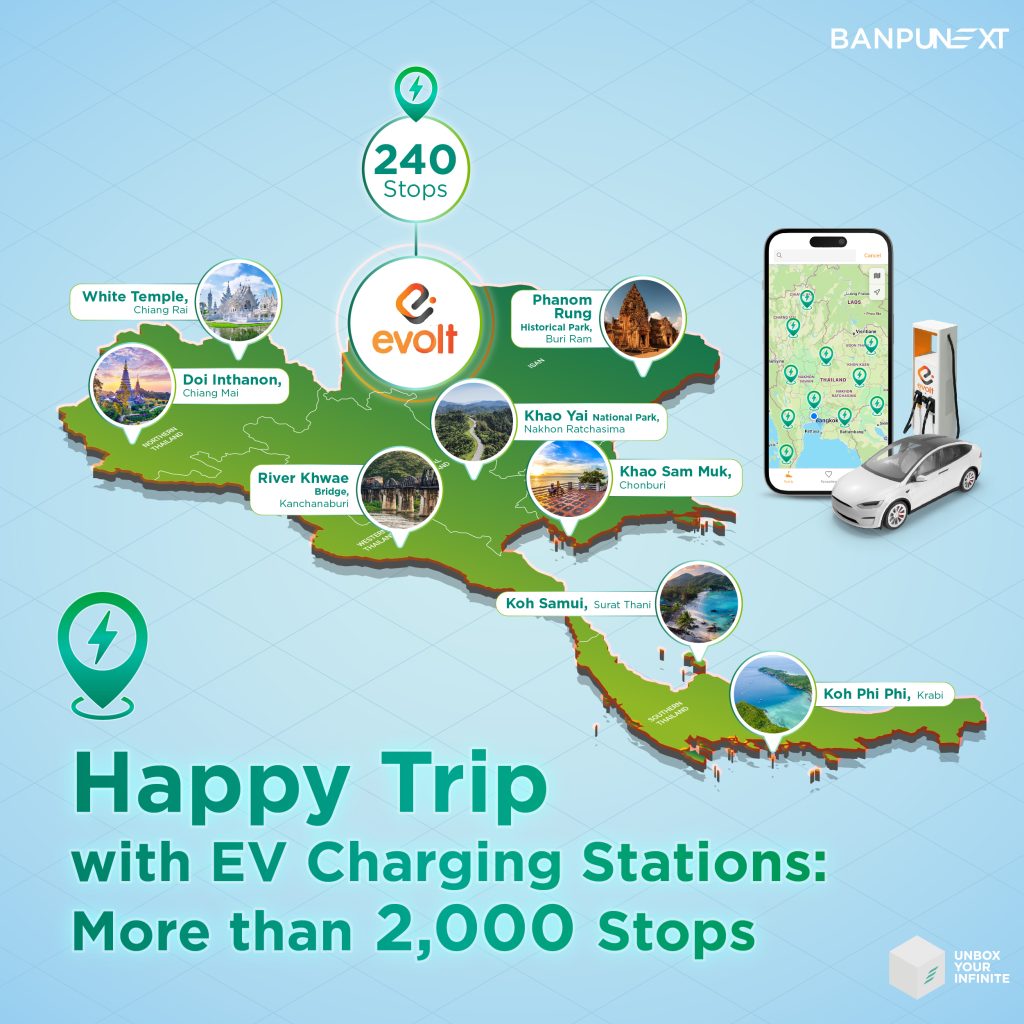As the world is gearing towards Net-Zero where it will be driven mainly by “clean energy”, Banpu NEXT, a subsidiary of Banpu, is a leading smart energy solutions provider in Asia-Pacific who committed to becoming Net-Zero Energy Provider, unveils top 5 new ‘clean energy trends’ that will enable Net-Zero society and businesses while also creating betterment of life for all. The 5 trends are Battery Energy Storage System (BESS), Building Integrated Photovoltaics (BIPV), Offshore Wind, Power-to-X and Green Hydrogen.
According to a report from the International Energy Agency (IEA), if the world achieves its Net-Zero target by 2030, the global market for clean energy technologies including, solar power system, wind power, EV batteries, and electrolysers for hydrogen will be worth around USD 650 billion a year*. With that said, Banpu NEXT foresees that energy technologies in the future will become variety, Greener and Smarter. The 5 new clean energy trends to watch are:
Battery Energy Storage System (BESS): A solution to manage electricity stability
Battery Energy Storage System (BESS) is an energy storage system that incorporates battery to store surplus energy and provide reserve capacity when the demand for electricity is high. BESS is distinguished for its ability to lower the fluctuation of renewable energy; secure stability and flexibility of energy management; and provide high storage capacity. Applicable with both household and large-sized power plants, the BESS can be installed anywhere and is easily movable. Banpu NEXT has incorporated the BESS from its subsidiary “Durapower”, a global leader in performance lithium-ion battery storage solutions, installed at solar PV hybrid power plant in Indonesia to enable 24-hour on-site electricity supply.
Building Integrated Photovoltaics (BIPV): An innovation for low-carbon buildings
The difference between Building Integrated Photovoltaics (BIPV) and the typical solar power system is that BIPV is an innovation that incorporates solar panels as part of the design and construction of various parts of buildings including roofs, awnings, and windows. BIPV enables automatic power generation from buildings which helps cut electricity bills, prevent heat, lower disturbing noises, and reduce CO2 emissions. The innovation also transforms the buildings into low-carbon or green ones.
Offshore Wind: An energy source that never runs out
A number of countries have roadmaps to leverage the use of wind power given it is a clean energy source that never runs dry, involves no fuel costs and has the highest potential to reduce CO2 emissions which can also bring about the country’s sustainable economic growth. The speeds and power of offshore wind are generally higher than on land which can generate more energy. A number of countries including Denmark, the United States, China and Japan are currently operating offshore wind farms.
Power-to-X: Way for industries to access clean energy
Power-to-X describes the conversion of renewable electricity from wind and solar to an various types of fuels and chemical including green hydrogen, ammonia and materials for chemical industry. These fuels can then be used in industrial plants, logistic and transportation, District Cooling System and many more. It is a technology that enhances the opportunity for businesses to be more environmentally friendly.
Green Hydrogen: One of the key piece for decarbonizing
Green hydrogen is defined as hydrogen produced by renewable energy. It creates no greenhouse gas and can be incorporated into various sectors. Green hydrogen can be used as a raw material for oil refinery and fertilizers and irons production; and as fuels for electricity generation and logistics. Although the production cost of green hydrogen is currently higher than other types of hydrogen, it is expected to lower in the future and green hydrogen will become more widespread.
Set aside various forms of clean energy, the use of technology such as Artificial Intelligence (AI), Internet of Things (IoT), Big Data and Cloud Computing as part of the production of clean energy is also a significant steppingstone to enhance the energy management, enabling real-time monitoring, control, and direction. Banpu NEXT has incorporated technology and digital platform with the company’s customized clean energy solutions that fit different business requirements in order to allow organizations to tap into the infinite of clean energy, accelerate smart business transformation, and achieve their ESG goals. At the same time, the company continues to scale up its clean energy business and develop new energy solutions in response to the future’s energy trends and support the transition of Net-Zero society.
*Energy Technology Perspectives 2023 By IEA
#BanpuNEXT #SmartEnergySolutionsForSustainability #NetZero







